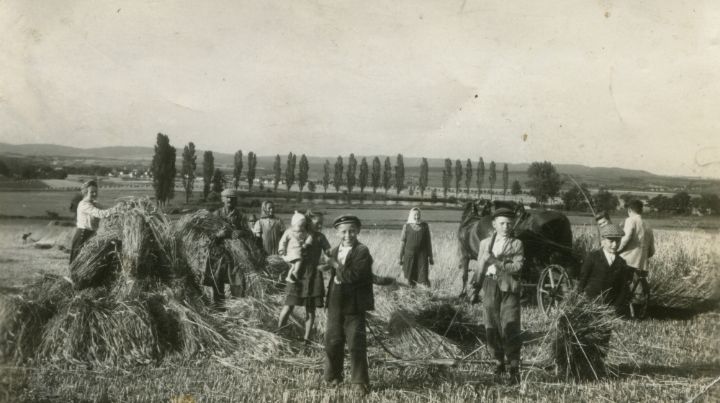The History of Disaster Prepping


Podcast: Play in new window | Download
Disaster prepping is nothing new. Did you know that disaster prepping and getting ready for potential hard times date back to the beginning of human history?
Disaster Prepping from Ancient Times to 1900
All we need to do to see the importance of preparedness is to look to the story of Noah and his family building the ark in preparation for a natural disaster.
The reality is that humans have taken disaster-prepping measures since the earliest time to get ready for the adversity they knew was coming.
Whether gathering and preserving food to get ready for winter, working to deal with Mother Nature, or readying themselves to overcome a host of other adversities, people have always worked to be prepared for problems that lay ahead. Lacking our modern conveniences, people had no choice other than to plan and prepare for the trying times they knew would come.
For example, people of the Middle Ages gathered and preserved as much food as possible during the summer months. They knew that a long cold winter was coming and did what they could to put aside food so they wouldn’t starve.
Until very recent times, preparing for the future was NOT an option. Preparing for the rough times that lay ahead was simply a way of life for thousands of years. The dark reality is that those who didn’t prepare stood a good chance of not living past the next difficulty.
Think about trying to survive the winter a few hundred years ago without a stack of wood, preserved food, or any number of other life-sustaining preparations.
Disaster Prepping from 1900 – 1970
As our relatively recent history shows, preparedness was an expected practice. Heck, it wasn’t considered disaster prepping or anything other than mainstream. It was a way of life to raise a garden, can some pickles, and be self-reliant. Nobody went to the store or restaurants on a daily basis.
As recently as most of the last century, people were encouraged to prepare and be self-reliant. Often, governments promoted preparedness in an attempt to rally their people to support a national effort.
The World Wars
 As the flames of world wars raged around the globe, many countries involved in the fights pushed their citizens to become more self-reliant.
As the flames of world wars raged around the globe, many countries involved in the fights pushed their citizens to become more self-reliant.
Here in the United States and other nations, people were encouraged to grow “Victory Gardens” to help keep the country fed during a time of food rationing.
Not becoming more self-reliant and prepared was considered unpatriotic at the time and counter to the nation’s war effort.
The effort was so strong that over 20 million victory gardens were planted within the United States. By 1944 victory gardens produced over eight million tons of fruits and vegetables.
To help put this into perspective, they produced 40% of all fresh fruits and vegetables consumed in the United States. At that time, the amount was equal to all U.S. commercial production.
In addition to growing victory gardens, people fearing possible attacks by the enemy began constructing home bomb shelters, many of which still exist today.
The Cold War
During the Cold War, the specter of nuclear war was an ever-present threat. The building of bomb shelters throughout the United States by individuals and local and federal governments increased.
One of the most famous examples of bomb shelters is the Greenbrier Resort, located in West Virginia, a short trip from Washington D.C. Construction of the Greenbrier, codenamed “Project Greek Island,” began in 1958.
Architects of the Greenbrier created it to house over 1,000 people, including the entire US Congress. The refuge remained in operation for over 30 years. Had the shelter not become known to the public in 1992, it would probably still be in operation today. While the Greenbrier may no longer be involved, other shelters are certainly part of the government’s continuity of operations plan today.
In addition to building shelters such as the Greenbrier, the government also mandated “duck and cover” education and drills. If you don’t recall these drills, ask someone a bit older, and they will probably recall taking part in nuclear bomb drills when they were young.
To see the emphasis put on preparedness for a nuclear attack, take a few minutes out of your day to watch the government’s public safety film, Atomic Alert. These drills shown in Atomic Alert are based on response measures similar to what is included in the US Army’s Field Manual, FM 3-4 NBC Protection.
Similar readiness and preparation efforts for nuclear war and other disasters continued well into the 1970s.
Disaster Prepping in the Survivalist Age (1970 – 1998)
As the world progressed through the 1970s, the next phase in the history of preparedness began in 1976. It was then that Kurt Saxon created the term “survivalism.”
Also, during this time, Howard Ruff wrote his famous preparedness book, Famine and Survival in America, which, based on the difficult financial times, created the groundwork for many of the concepts of our modern prepper movement.
Saxon and Ruff laid their groundwork for the modern prepper movement. Modern firearms training and competition also took shape and provided additional influence to the preparedness community. During this time, USMC Lieutenant Colonel Jeff Cooper founded the American Pistol Institute, now known as Gunsite Academy.
The preparedness community and movement grew through the 1980s and into the 1990s.
The media and some parts of society started placing a negative label on preparedness. They didn’t judge people and groups on their merits. The media began to wrongfully label anyone who believed in preparedness as crazy, racist, extremist, and anti-government. Unfortunately, while the labels were untrue for most preppers, they did drive much of the preparedness movement into the shadows. The labels also created an artificial barrier that prevented many from becoming better prepared.
Disaster Prepping from 1999 – Present
As time passed, the threat of Y2K became imminent, which helped relax the public perception of preppers and the community as a whole. Y2K became a concern due to the fear of a computer glitch. Many feared our digital-based infrastructure would simply shut down at the start of the new century. This fear caused the mainstream media to run stories of potential power grid failures and a possible collapse of society.
Luckily, the prophecies of Y2K never happened, and the new millennium arrived without any Y2K-related problems.
The survivalist movement gradually rebranded into today’s modern prepper movement. With the transition to the prepper movement, the use of the word “survivalist” subsided. Instead, the term “prepper” took its place.
While the prepper movement continues to be considered a fringe element, it is witnessing an increase in acceptance and participation. Also helping to cement the prepper movement’s place in society were the 9-11 terrorist attacks on the United States.
These attacks set the stage for more people to join the movement as political division and uncertainty raged through today.
The Bottom Line on Disaster Prepping History
From the beginning of time until today, wise people have made efforts to get ready for difficult times. Sometimes it’s a matter of what you put aside. Other times, it’s a matter of skills, and still others, it’s all about your mindset.
As the Roman poet Virgil said,
“Every calamity is to be overcome by endurance.”
Additional Resources:
Stay safe,

1 Comments
Leave a Comment




Join Mind4Survival!
Stay informed by joining the Mind4Survival! 100% Secure! 0% Spam!
Follow Us!
Affiliate Disclosure
Mind4Survival is a free, reader-supported information resource. If you make a purchase through our link, we may, at no cost to you, receive an affiliate commission.



This is the best blog so far keep up